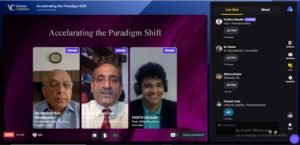This Article has been contributed by Doc Aggarwal (A Good Friend)
It provides a glimpse into the selfless service of medical fraternity in fight against the Pandemic
Ash
“The BP is dropping, we should start inotropes”, was the breathless interjection from the treating physician.
“SpO2 levels are also dropping, seemed ok some time ago”.
The patient, a senior citizen of great importance did not look good. He appeared a little listless, a little confused and frankly very ill. He is much liked, very popular and has done only good to people. Everyone is concerned.
They confer privately. “We need to get him to a better equipped centre… That is the only hope”.
“But it is a four hour journey. Will he be able to undertake it?”
“What is the other option? We’ll send a doctor along with him. It’s eight in the morning, if we start early enough, he will be at the hospital by noon. That’s not too bad”.
And so the decision is taken. We’ll send him with adequate oxygen, IV fluids, medicines and a doctor. The front section of the ambulance would be sealed, so that the driver stays safe. Air-conditioning will cause air circulation, and endanger the driver, so it will be switched off. The windows will remain open for cross-ventilation. The doctor would be exposed to COVID from the patient.
Ash was the natural choice. He is a doctor already suffering from COVID, though mostly asymptomatic, some mild cough, fever, bodyache. Nothing that cannot be handled.
Nothing, except of course, Murphy and his laws. The transfer kept getting delayed, hour after hour. First it was stabilizing the patient, then the paper-work, then ensuring adequate oxygen then adequate fluids and so on… By the time they finally started, it was 01:30 pm. The outside temperature had climbed to 42 deg Celsius. The patient was not as well compensated as he was in the morning. Ash, was hot and with the dehydration COVID brings in, thirsty. His fever had increased and he was not feeling too well.
Ash kept it together, though. Irrespective of his personal discomfort, he maintained hemodynamic stability, maintained oxygen levels, kept the patient’s fever under check, made sure he remained lucid.
On the other hand, Ash himself was hot, thirsty, badly feverish and had severe bodyache. He held on steadfast.
The final leg to the hospital was a little more torrid. The patient’s BP started dropping a little and oxygen saturation suffered. Ash made the necessary adjustments. They reached safely. Phew… what a relief.
After the patient reached the ICU, Ash finally breathed. He spoke to the DMO, “I need a room for 15 min or so”.
Inside the room, he disregarded the fever, the bodyache, the dehydration, the awfully sick feeling. He folded his pant cuffs, washed his hands and feet and turned west.
“Bismillah, in the name of Allah the most merciful, the benevolent”. He prayed, and had his first sip of water since sunrise, as he opened his Roza fast.
Tomorrow is another day
For regular updates please register here –


